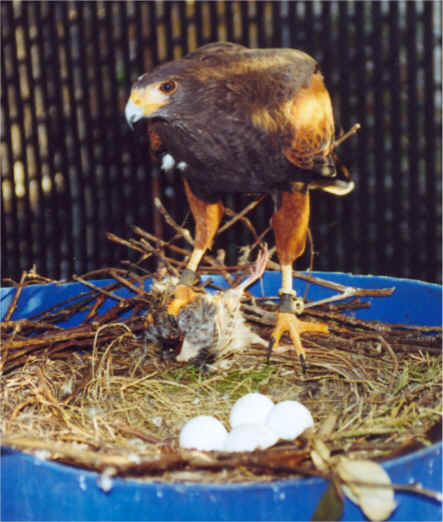
Baywing Database Home Page
BaywingDB Pedigree Data Entry Form
BaywingDB Hunting Performance Data Entry Form
The entire contents of BaywingDB and set of forms in BreedMate software format (you must purchase BreedMate in order to view the data in this format).
The entire contents of BaywingDB in Excel97 format. This is useful for sorting and browsing the data.
The entire contents of BaywingDB in comma-delimited ASCII text for import into any spreadsheet or database program.
Toby Bradshaw's Hawking and Falconry Pages
The purpose of the Baywing Database (BaywingDB) is to collect, store, analyze, and distribute information on Harris's hawks (Parabuteo unicinctus) used for falconry. As Harris' hawks become domesticated and specialized for falconry through captive breeding, it will become increasingly important for falconers and breeders to have comprehensive pedigree records linked to hunting and breeding performance data.
What are the advantages to participating in the BaywingDB project? If you are a breeder, the database records will allow you to track the performance of the birds derived from your breeding project. You will be able to determine the relationship of new breeding stock to your current program and to the programs of other breeders. If you are a falconer, the database will help you find a breeder and perhaps a particular pair of birds which produce the kind of offspring you'd like to fly. You can find out how the relatives of your hunting birds are performing for other falconers around the world.
And, as a bonus for entering your hawk's information in BaywingDB, consider the fact that several lost Harris's hawks have been returned to their falconers because the hawk's band number and owner's name are in the database!
We have already seen the beginnings of selective breeding designed to produce captive-bred Harris's hawks with superior characteristics for falconry. Harris' hawks are bred for desirable physical properties, such as flight speed, quickness, body size, strength, and footing. Even more important mental traits (which vary tremendously among the offspring of current breeding stock) include tameness, trainability, appropriate social behavior in group hawking, working well with dogs, intelligent use of height and position in the field, and desire and persistence in the pursuit of game. There are also marked differences in breeding qualities, such as the number and hatchability of eggs produced by particular pairs, and the tolerance of breeding birds for human disturbance.
Of course, not all of a Harris's hawk's falconry performance is determined by genetics. Proper rearing, training, and handling are essential to success in the field. But the accumulated knowledge of falconers and breeders, some of whom have bred and flown literally hundreds of individual Harris's hawks, provides convincing evidence that genetics plays a major role in determining the ultimate potential of a Harris's hawk. It is certainly true that the average Harris's hawk is more than adequate for the average falconer, but most falconers prefer to start with the very best available bloodlines so that their substantial investment in time and effort is rewarded fully.
The first step in a long-term effort to domesticate and improve Harris's hawks for falconry is to keep accurate, detailed, and complete pedigree records. Every Harris's hawker in the world can help with this part of the BaywingDB project. Forms for submitting pedigree information on your falconry birds and breeding stock are available.
As with the selective breeding of gun dogs and racehorses, pedigree information must be tied to performance data. A form for submitting hunting performance data is designed for this purpose.
For more information about BaywingDB, see an article which appeared in the August 1999 Hawk Chalk.
For more information on the Baywing Database,
contact
Toby
Bradshaw.
Last revised:
15-Jul-2004